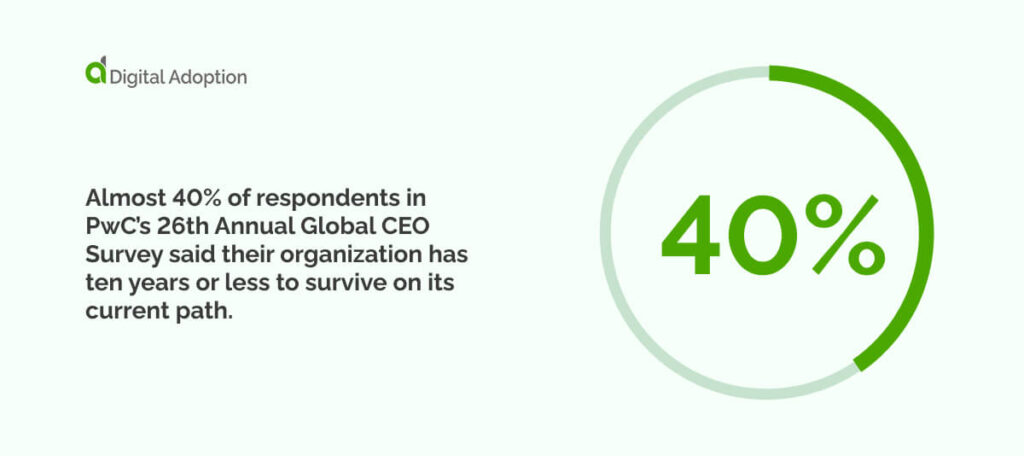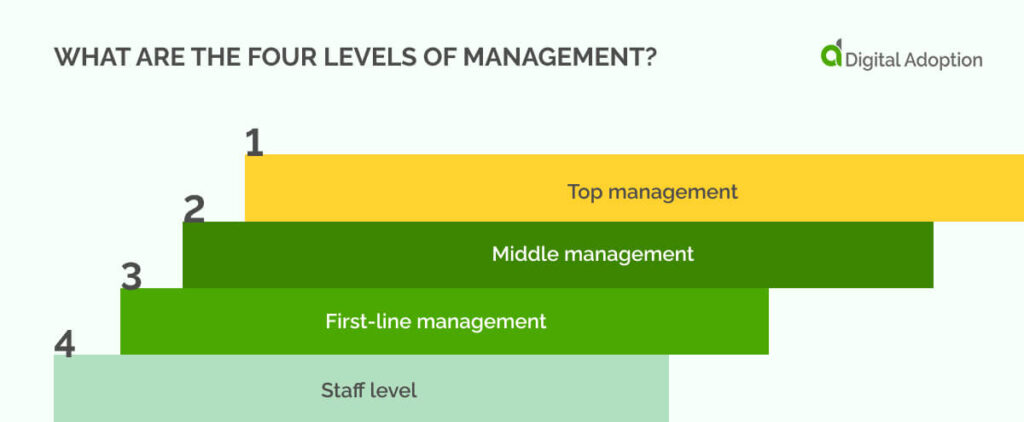A strong organizational structure is a necessary prerequisite for business success today. Without it, core company processes can become siloed, disparate, and unfocused.
A future-ready organization understands that driving progress means having a strong hierarchical structure. This includes sourcing and managing top talent who can execute an organizational vision.
At the top of this structure are several C-suite roles. These positions consist of several top-level executives responsible for steering an organization.
However, the makeup of the C-suite can vary depending on the business. Different industries, strategies, and end goals require different expertise.
This article will explore C-suite roles, what they are, what they do, and the 12 main types of executive positions common across modern business.
What is the C-Suite?
C-suite roles represent those in top-level positions at an organization. These executives and authoritative figures oversee critical processes and key decisions.
While a roster of C-suite talent can be developed as the company grows, some senior positions are held by those who directly had a hand in the company’s creation. Think Richard Branson or Bill Gates. These figureheads often have a hand in the company’s holistic vision and operational resilience.
As you know, high-ranking job titles at an org typically begin with “chief,” I.e., Chief Executive Officer (CEO), Chief Information Officer (CIO), and Chief Operating Officer (COO). This is where the term “C-suite” finds its origins.
Each C-suite member oversees a different domain within the company’s chain of operations. Each individual is key to driving progress toward an organization’s objectives.
What does the C-suite do?
As we know, C-suite figures lead in a particular business area. Together, they form a complete hierarchical structure that effectively steers all organizational segments.
Almost 40% of respondents in PwC’s 26th Annual Global CEO Survey said their organization has ten years or less to survive on its current path, highlighting concerns beyond just C-suite pessimism. This shows that the pressure on C-suite executives to drive change and innovation is greater than ever.

While some positions are interchangeable depending on the company, all C-suite structures will have a CEO.
All companies require strong leadership and someone who can steer the ship towards success. The CEO may be the person who founded the company or someone who ascended corporate ranks over time.
The next in the chain of importance may be the CFO or COO. These individuals are responsible for making critical operational and financial decisions—non-negotiable roles of any successful firm.
From here, the hierarchical structure begins to change depending on the type of business. For example, firms handling vast amounts of sensitive data will house a Chief Compliance Officer (CCO) who ensures the company complies with data privacy regulatory frameworks.
The number of C-suite roles may also vary depending on the type of organization. In an enterprise-level firm, C-suites could hold 15+ positions across diverse domains. In small-to-medium-sized enterprises (SMEs), only two or three senior positions may be needed.
No matter the structure, C-suite individuals work in unison to deliver core plans and policies that strengthen business objectives.
Types of C-suite roles & responsibilities
Now that we understand the role of the C-suite, let’s take a closer look at 13 common C-suite positions found in today’s organizations.
These roles will be grouped according to functional hierarchy, focus areas, and interdependence within a standard organizational structure.
Let’s take a closer look:
Chief Executive Officer (CEO)
The Chief Executive Officer (CEO) is the top-most executive responsible for overall strategy, vision, and decision-making. CEOs are typically public-facing, serving as the company’s optical figurehead and driving company ethos.
CEOs may be the company’s founder, someone who worked their way up, or someone appointed by a board of directors. Either way, a major duty of a CEO is to act as a bridge between these senior stakeholders and the operational apparatus.
CEO responsibilities include:
- Driving performance: Ensuring the company meets its goals and runs smoothly.
- Managing risk: Identifying and dealing with potential problems early.
- Shaping culture: Creating a positive work environment that helps the company grow.
- Representing the company: Speaking to the public and media on behalf of the business.
CEO skills include:
- Strategic thinking: Planning for the company’s growth and success.
- Adaptability: Adjusting plans when unexpected changes happen.
- Financial oversight: Understanding financial data to make smart decisions.
- Team building: Hiring the right people and developing strong teams.
Chief Strategy Officer (CSO)
Without clear direction and focus, resources lose value. The Chief Strategy Officer (CSO) drives long-term strategy, working with the CEO to set goals.
CSOs plan and organize actions that align with the company’s vision. Reporting to the CEO and CFO, they work with senior leaders and the board. They also help shape strategies and guide initiatives from start to finish.
CSO responsibilities include:
- Driving change: Identifying weak spots, setting goals, and leading efforts to fix them.
- Mentoring: Teaching skills, sharing knowledge, and helping leaders grow.
- Market observation: Watching competitors, customer trends, and new risks.
- Strategist: Creating long-term plans that balance resources with company priorities.
CSO skills include:
- Strategic planning: Turning ideas into clear, actionable steps.
- Data analysis: Using trends and numbers to guide decisions.
- Time management: Setting priorities and focusing on important tasks.
- Managing stakeholder relationships: Building trust and ensuring alignment with boards, investors, and teams.
Chief Business Officer (CBO)
The Chief Business Officer (CBO) oversees overall business operations, drives revenue, and aligns business units.
They must use business knowledge and leadership skills to create strategies to support growth. The CBO works with other executives, such as the Chief Compliance Officer (CCO) and Chief Marketing Officer (CMO), to develop business strategies, manage finances, allocate resources, and build key partnerships.
CBO responsibilities include:
- Cross-functional collaboration: Aligning teams to work toward mutual goals.
- Business development: Identifying new growth opportunities.
- Operational oversight: Ensuring efficient daily operations.
- Risk management: Addressing and minimizing business risks.
CBO skills include:
- Leadership: Guiding teams to achieve goals.
- Communication: Sharing clear ideas with stakeholders.
- Relationship building: Developing strong connections inside and outside the company.
- Technology understanding: Using technology to streamline operations.
Chief Transformation Officer (CTO)
A Chief Transformation Officer (CTO) leads organizational change to help the company adapt to market shifts. They drive change through research, leadership, and strong communication. These skills are key to guiding staff through transformation and ensuring successful, company-wide acceptance of organizational change.
CTO responsibilities include:
- Leading technology strategy: Aligning tech with business goals.
- Driving innovation: Overseeing new tech development.
- Tech alignment: Ensuring systems meet operational needs.
- Managing teams: Building and guiding tech teams for success.
CTO skills include:
- Strong business sense: Understanding how tech supports business growth.
- Industry insight: Recognizing trends and adapting.
- Technical knowledge: Leading development and innovation.
- Talent awareness: Identifying and managing top tech talent.
Chief Financial Officer (CFO)
A Chief Financial Officer (CFO) manages the company’s financial health. They track and analyze financial data, create budgets, and ensure legal compliance. The CFO provides leadership in managing company resources and helps make decisions to drive economic success.
CFO responsibilities include:
- Financial strategy: Planning how to manage the company’s finances.
- Budgeting and forecasting: Overseeing how money is spent and predicting future needs.
- Risk management: Identifying and managing financial risks to protect the company.
- Reporting and compliance: Ensuring financial records are accurate and meet legal standards.
CFO skills include:
- Strong financial acumen: Deep understanding of financial data and trends.
- Strategic thinking: Connecting financial plans with company goals.
- Attention to detail: Ensuring financial accuracy in all decisions.
- Leadership and communication: Leading financial teams and advising other executives.
Chief Information Officer (CIO)
A Chief Information Officer (CIO) leads an organization’s technology strategy. They ensure that IT systems, software, and infrastructure align with business goals. The CIO drives digital transformation, oversees tech operations, and manages how technology is used to improve efficiency and innovation across the company.
CIO responsibilities include:
- IT strategy: Creating tech plans that support business growth.
- Technology management: Overseeing IT systems and software.
- Innovation: Leading digital transformation and implementing new tech.
- Cybersecurity: Protecting data and networks from risks.
CIO skills include:
- Technical expertise: Strong knowledge of IT systems and software.
- Strategic thinking: Aligning technology with business needs.
- Problem-solving: Quickly fixing tech issues.
- Leadership: Managing IT teams and collaborating with other departments.
Chief Technology Officer (CTO)
A Chief Technology Officer (CTO) is responsible for the company’s technology strategy and development. The CTO also manages research, leads tech teams, and watches technology trends to keep the company current.
CTO responsibilities include:
- Communicate progress: Provide updates on tech strategies to leadership.
- Collaborate with teams: Work closely with engineers and product managers.
- Evaluate systems: Choose and implement tech solutions that scale.
- Ensure compliance: Follow industry standards and regulations.
CTO skills include:
- Cybersecurity: Protect systems and data from cyber threats.
- Change management: Lead the process of tech transformation.
- Project management: Make sure tech projects are finished on time.
- Technical insight: Keep up with new and emerging tech trends.
Chief Product Officer (CPO)
A Chief Product Officer (CPO) leads the product strategy and oversees the entire product lifecycle. They manage product vision, development, and delivery and guide teams through the development process to ensure the product meets customer needs.
CPO responsibilities include:
- Set product vision: Define long-term goals and direction.
- Drive development: Lead the design, build, and rollout of products.
- Collaborate with teams: Work with marketing, design, and engineering.
- Track product performance: Use data to refine product offerings.
CPO skills include:
- Strategic thinking: Plan for the future of the product.
- Innovation: Identify and create new product opportunities.
- Project management: Oversee timely and efficient execution.
- Market knowledge: Stay aware of customer and market trends.
Chief Marketing Officer (CMO)
A Chief Marketing Officer (CMO) drives marketing strategies and brand management. They focus on customer acquisition and retention, ensuring that marketing efforts are targeted and measurable and leading to growth in customer engagement and market presence.
CMO responsibilities include:
- Brand management: Shape and maintain the company’s brand image.
- Strategic planning: Create and manage marketing campaigns.
- Customer engagement: Build relationships to improve customer loyalty.
- Marketing analytics: Track data to improve marketing outcomes.
CMO skills include:
- Analysis to action: Convert data insights into marketing strategies.
- Market insight: Stay aware of market shifts and trends.
- Customer advocacy: Focus on understanding customer needs.
- Marketing expertise: Apply knowledge of marketing tools and methods.
Chief Experience Officer (CXO)
A Chief Experience Officer (CXO) focuses on improving both customer and employee experiences. They ensure customer satisfaction while advising workplace strategies to boost employee retention and reduce turnover.
CXO’s responsibilities include:
- Customer advocacy: Represent customer interests in decision-making.
- Team building: Foster collaboration and create strong internal teams.
- Leadership: Lead initiatives for positive customer and employee outcomes.
- Metrics: Develop performance metrics to track success and areas of improvement.
CXO skills include:
- Collaborative leadership: Work with other leaders to align initiatives.
- Agility and adaptability: Respond to changes in customer or employee needs.
- Strategic thinking: Plan for both short- and long-term improvements.
- Decisions backed by data: Use data to guide strategies and track results.
Chief Human Resources Officer (CHRO)
A Chief Human Resources Officer (CHRO) leads HR functions, including recruitment, employee relations, and compliance. They focus on hiring talent, building company culture, and improving employee satisfaction. CHROs also work to retain employees and help manage workplace changes.
CHRO responsibilities include:
- Talent management: Oversee hiring and staff development.
- Workplace culture: Promote a positive, inclusive environment.
- Employee support: Ensure a good employee experience.
- Manage change: Lead staff through company shifts.
CHRO skills include:
- Data analysis: Use data for better HR decisions.
- Communication: Expert listening and speaking skills.
- Problem solving: Can effectively resolve workplace issues.
- Culture building: Promotes a strong company culture.
Chief Legal Officer (CLO)
A Chief Legal Officer (CLO) manages legal risks and ensures the company follows laws and regulations. They develop strategies to prevent lawsuits and protect the company’s reputation. The CLO keeps the company safe from legal issues and financial losses.
CLO responsibilities include:
- Contract oversight: Manage contracts and get necessary approvals.
- Compliance resolution: Solve legal and regulatory issues.
- Litigation management: Handle and prevent legal cases.
- Legal strategy development: Create strategies to guide legal actions.
CLO skills include:
- Stakeholder communication: Explain legal matters to others in the company.
- Ethics and compliance: Understand laws and ethical guidelines.
- Impartiality: Make fair legal decisions.
- Legal knowledge: Stay updated on various areas of law.
Chief Compliance Officer (CCO)
A Chief Compliance Officer (CCO) ensures the company follows laws and regulations. They create and manage the compliance program, adapting it as rules change. With new technologies like ChatGPT, the role of CCO becomes even more important. They protect the company’s reputation and reduce risks.
CCO responsibilities include:
- Regulatory compliance: Define and follow legal requirements.
- Compliance planning: Update the yearly compliance plan.
- Program implementation: Oversee compliance actions.
- Risk monitoring: Track and manage potential risks.
CCO skills include:
- Timely decision-making: Make quick, effective choices.
- Technological skills: Use tools for compliance tasks.
- Legal knowledge: Stay informed about laws and regulations.
- Timely decision-making: Quick decisiveness when met with adversity.
How will C-suite roles adapt going forward?
Looking ahead, C-suite roles will change as businesses race to adapt to new demands.
Digital transformation will push more teamwork between departments. Leaders will need to manage connected functions. Chief officers must focus on data security, tech integration, and flexible processes. As customer needs shift, executives will update strategies fast. Sustainability, ethics, and employee well-being will guide decisions. C-suite leaders will rely on cross-functional teams with specialized knowledge. Their ability to adapt, innovate, and lead teams will help them face future challenges.

People Also Ask
-
What is the hierarchy within the C-suite?The C-suite includes the top executives who make important decisions for the company. The CEO is at the top, followed by roles like the CFO, COO, and CTO. These leaders focus on the company’s overall strategy, finance, operations, etc.
-
Is C-Suite above VP?Yes, the C-suite is above VPs. VPs are senior managers in charge of specific departments. They report to the C-suite, which oversees the entire company.
-
What are the four levels of management?The four levels of management are: Top management: The C-suite makes high-level decisions. Middle management: Directors and VPs who manage departments. First-line management: Supervisors handling day-to-day operations. Staff level: Employees who carry out the work.













